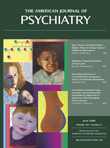Dr. Solomon and Colleagues Reply
To the Editor: Dr. Babbar raises two important concerns regarding the design of our study. First, the study focused on combat stress reaction, which is not a very well defined condition. Second, the study included the possibility that allocation of treatment modality was somewhat affected by the soldiers’ psychological condition.
With regard to the first point, it is important to note that casualties of combat stress reaction comprise one of the most thought-provoking, yet rarely studied, clinical populations. Combat stress reaction is a condition that results from psychological breakdown on the battlefield, and it is characterized by a polymorphous and labile symptom profile, which may include emotional and physical numbness, withdrawal, depression, and a paralyzing fear of death (1) . Moreover, findings consistently reveal that the intensity and long-term course of PTSD seem to be a function of the occurrence of combat stress reaction during battle (1) . Therefore, it is important to distinguish between combat stress reaction and noncombat stress reaction casualties in order to understand the formation and consolidation of PTSD. This conclusion is consistent with claims that have been made after the introduction of acute stress disorder to DSM-IV. It is important to distinguish between individuals who had exhibited an initial stress reaction to trauma exposure and those who initially appeared to be unaffected. Combat stress reaction seems to be a specific variant of acute stress disorder because there are some parallel symptoms observed in both conditions (e.g., dissociation).
With regard to the second point, we can only reply that this is the “nature of the beast.” Making systematic research on the battlefield is a very difficult or even impossible undertaking, and mental health professionals are influenced by a wide variety of uncontrollable factors, ranging from basic material constraints to soldiers’ psychological condition, when assigning soldiers to a treatment modality. We recognize that we were unable to control for all the factors that might have influenced allocation of treatment modality, but we find it extremely impossible to think about a naturalistic research design during battle that would be able to control for such factors.
1. Solomon Z: Combat Stress Reaction: The Enduring Toll of War. New York, Plenum Press, 1993Google Scholar



